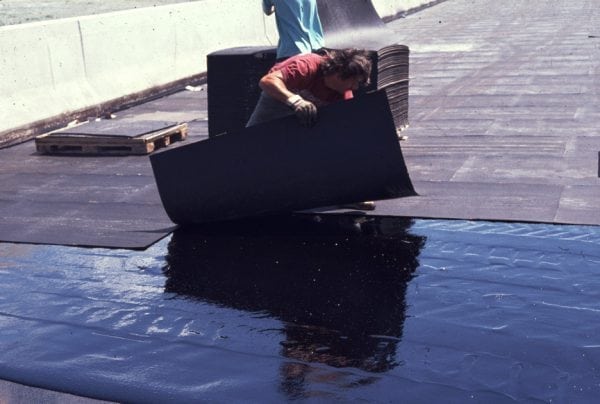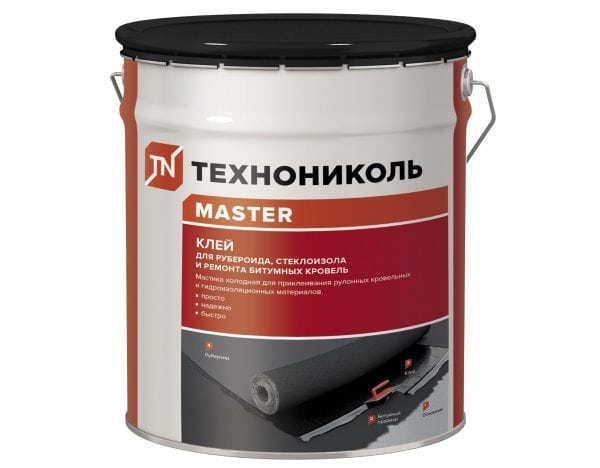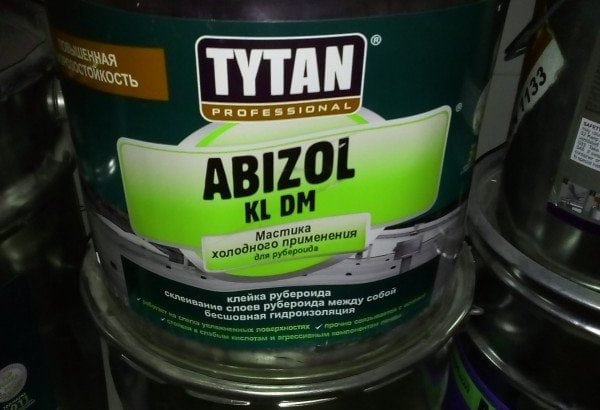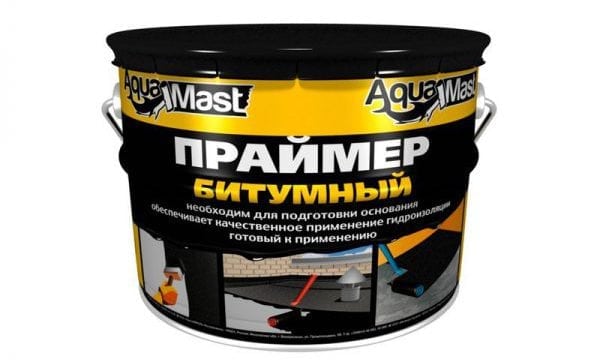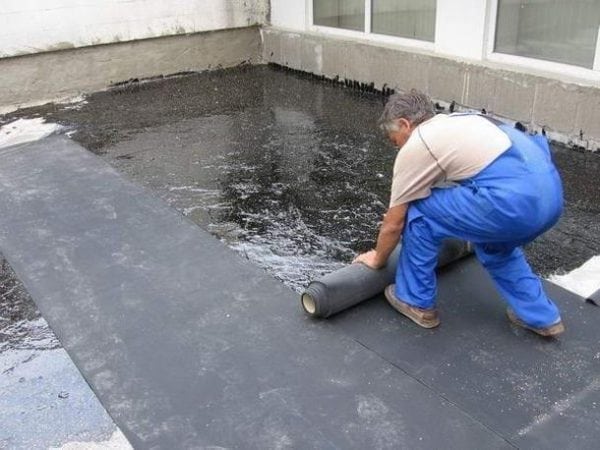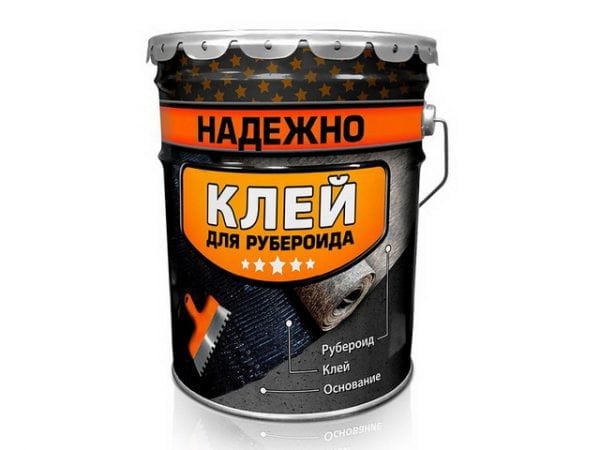Glue for roofing material consists of several components: bitumen, solvent, filler and various additives. It is used during roofing to fix and seal joints of this material.
- The main methods of fixing roofing material
- Clay Technonikol
- Mastic ABIZOL KL DM TYTAN
- Bituminous mastic AquaMast
- Glue on Technonikol: a brief instruction
- Making mastic for ruberoid do it yourself
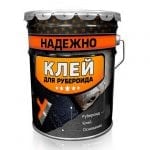
The main methods of fixing roofing material
Ruberoid is a complex material in terms of its attachment to the roof surface, but the low price and the ability to lay on any roof make it popular. It can also be used as a waterproofing layer, laying on the foundation.
Previously used the method in which the bitumen sheet was laid layer by layer and nailed. Practice has shown that this is short-lived, so today this method is practically not applied.
Bonding roofing felt with a special mastic greatly simplified the work with roofing material. This coating is durable, with joints that do not leak. A significant minus is the mandatory heating of the composition for the ruberoid sticker. For this, special devices are needed, which is not very convenient, especially with independent work.
Modern compositions based on bitumen are an ideal option that does not require additional training. Among the most famous types of glue:
- TechnoNIKOL;
- ABIZOL KL DM TYTAN;
- AquaMast.
Adhesives provide not only reliable fastening of roofing material to the surface, but also good sealing of joints.
to contents ↑Clay Technonikol
TechnoNIKOL is a composition based on bitumen with the use of modern modifying additives, solvent and fillers. It is used for work with roofing material of all grades, as well as with glass insulation and other rolled materials used in construction for waterproofing. Bitumen mastic glues the roof to concrete, cement-sand and other substrates.
Note! Before laying the roofing material on the glue, preparatory work is required. The adhesive is applied only to a clean coating.
Glue can be used at temperatures from +5 to +35 ° C. At a relatively low price (500-600 rubles per 10 liters), the quality of the product meets international standards. The only drawback when working with mastic is its high consumption - 1.5–2 kg per 1 sq. m
to contents ↑Mastic ABIZOL KL DM TYTAN
The modern adhesive composition of a thick consistency is used for roofing material of all grades. The main characteristics of the mastic:
- temperature range of work - from +5 to +35 ° C;
- consumption of 0.8–1.5 kg per 1 sq. km. m;
- drying time of at least 24 hours;
- the ability to work on slightly damp surfaces;
- resistance to weak acids and alkaline bases;
- the final set of properties takes 14 days.
The adhesive is ready to use when cold. Apply it with a roofing brush or mackerel. When laying in several layers, they wait until the first layer dries, and only then continue to work.
to contents ↑Bituminous mastic AquaMast
This multicomponent mixture is designed specifically for use by individuals and small organizations with little construction experience. Unlike the professional line of mastics:
- less technological;
- not intended for industrial volumes with a high speed of work performed;
- not suitable for roofs with special operating conditions.
Suitable for most types of solid substrates, including wood. It is considered the best in its price category, due to:
- high resistance to temperature differences;
- low consumption of 0.8-1.8 kg per 1 square. m;
- maintaining the uniformity of texture and properties during freezing;
- a wide range of temperature use: from –10 to +40 ° С;
- a short set of final properties - 7 days.
to contents ↑Important! When using AquaMast mastic at temperatures below +5 degrees, keep the mixture in a warm room for at least 24 hours.
Glue on Technonikol: a brief instruction
Modern and high-tech tools do not require certain preparatory work. Just follow the instructions:
- Prepare the surface for the application of mastic: clean from dust, dirt and other construction impurities. If old material (such as resin) is present on the roof, remove it completely. Dry the surface.
- Eliminate irregularities and cracks with concrete mortar.
- Apply a special primer that will make the surface smoother to ensure a snug fit.
- Apply glue with a notched trowel, carefully coating the joints with other elements.
- Apply a tape of roofing material and roll it with a roller from the middle to the edges. If air bubbles form, pierce them and spread the canvas over the surface.
- Overlay the next sheet with an overlap of 10 cm.
- In addition, coat the joining points of the canvases.
- Let the first layer dry for 12 hours. Then apply the second and third (if necessary) in the same way.
to contents ↑Important! Do not use mastic indoors. Wear suitable clothing and gloves when handling the product.
Making mastic for ruberoid do it yourself
There are two options for preparing the adhesive base for roofing material, available for self-realization: cold and hot. Both methods are not inferior to each other in technical characteristics. The trains are prepared according to the following scheme:
- Cold mastic - from bitumen and solvent in a ratio of 3: 7, respectively. As a solvent, use gasoline, diesel fuel or kerosene. Melt bitumen first, then cool to 85 degrees, add the second component and mix thoroughly. Such a mixture maintains a liquid state at 20 degrees, therefore it is called “cold”.
- Hot mastic - based on bitumen and filler in the form of limestone, chalk, peat crumbs, talc, alabaster. Put bitumen in the amount of 8 kg in a large container and gradually heat. Add 1.5 kg of filler pre-sieved from debris. Pour in 0.5 kg of used oil. In this case, a temperature of 200 degrees should be constantly maintained in the tank. Such bitumen will slightly “hiss” and emit gray smoke, which indicates the correct preparation of mastic.
Important! The process of laying with hot mastic requires constant heating of the composition, so during operation use a container with thick walls - a standard bucket will quickly burn out.
Both versions of the manufacture of mastics are suitable in cases where it is necessary to patch up a small area of the roof. The consumption of self-prepared composition is large in comparison with a professional one. In addition, homemade mastic is not stored in case of incomplete use.
Fastening roofing material with the help of modern adhesives has simplified the work of builders and installers, as well as individuals. Means are already ready for use and do not require special skills. When working with bitumen mastic, follow the instructions for use, as well as the temperature regime specified by the manufacturer. Properly selected glue will increase the life of the roof.

